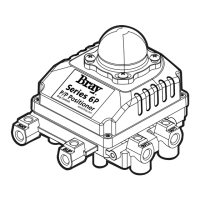Bray Series 6P
Operation and Maintenance Manual
10
5. Piping Connections
NOTICE
To avoid introducing moisture or dust, both supply
andsignalairshouldbeclean,dry,andltered
instrument air.
Supply Pressure Condition
1. Dry air with dew point of at least 50°F (10°C)
lower than ambient temperature.
2. Avoid dirty or oily air. Filtered air is recom-
mended in compliance with ANSI/ ISA-573
1975 (R1981) instrument grade.
3. Do not use beyond the range of
20-100 psig (1.4 - 7.0 barg) supply air.
4. Setairlterregulator’ssupplypressure10%
higher than the actuator’s spring range pressure.
Pipe Condition
1. Make sure the inside of tubing is clean and clear.
2. Do not use tubing that has been pinched or has
holes.
3. Tomaintainproperowrate,useatubesizethat
is at least ¼” (6mm) inner diameter.
4. Do not use extremely long tubing systems.
Itmayaffecttheowrateduetoexcessive
pressure drop.
Piping connection with actuator
Series 93 Spring Return Actuator
When mounting on the Bray S93 Spring Return
Actuator, OUT 1 should be connected to port A (left
port when facing the ports) and OUT 2 should be
plugged. This generates increasing pressure, forcing
the pistons away from each other, causing a counter-
clockwise rotation compressing the springs with
increasing signal to the positioner. When mounting
to other manufacturers rack and pinion actuators or
other actuator types, check actuator documentation to
determine proper connection.
Series 92 Double Acting Actuator
When mounting on the Bray S92 Double Acting
Return Actuator, OUT 1 should be connected to port
A (left port when facing the ports). OUT 2 should be
connected to port B (right port when facing the ports).
These connections will cause the pistons to move
away from each other causing a counter-clockwise
rotation with increasing signal to the positioner, and
clockwise on decreasing signal. When mounting to
other manufacturers rack and pinion actuators or
other actuator types, check actuator documentation to
determine proper connection.
OUT 1
OUT 2
A
B
OUT 1
OUT 2
A
B
Figure 9 - Single Acting
Figure 10 - Double Acting

